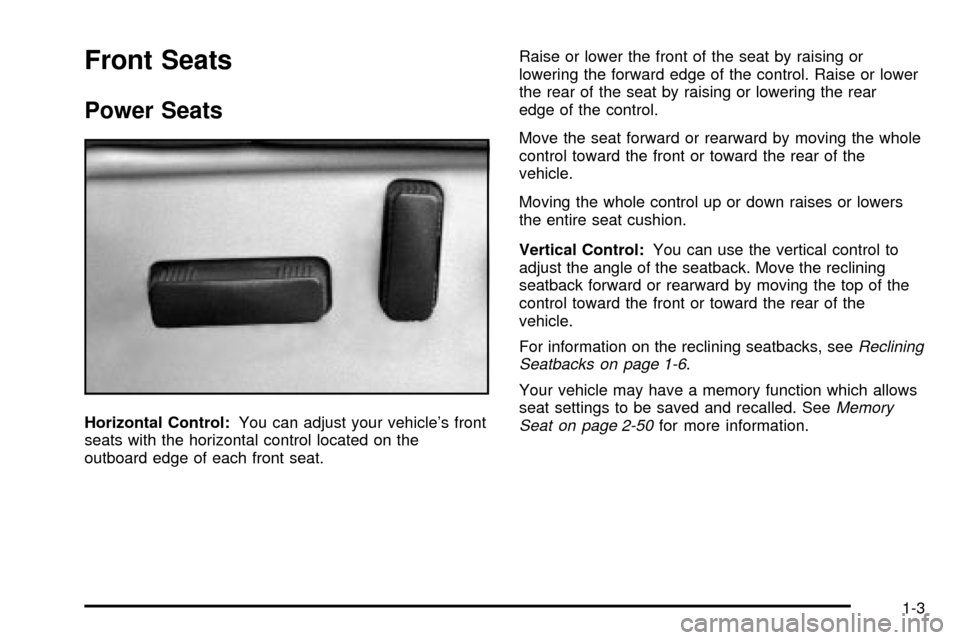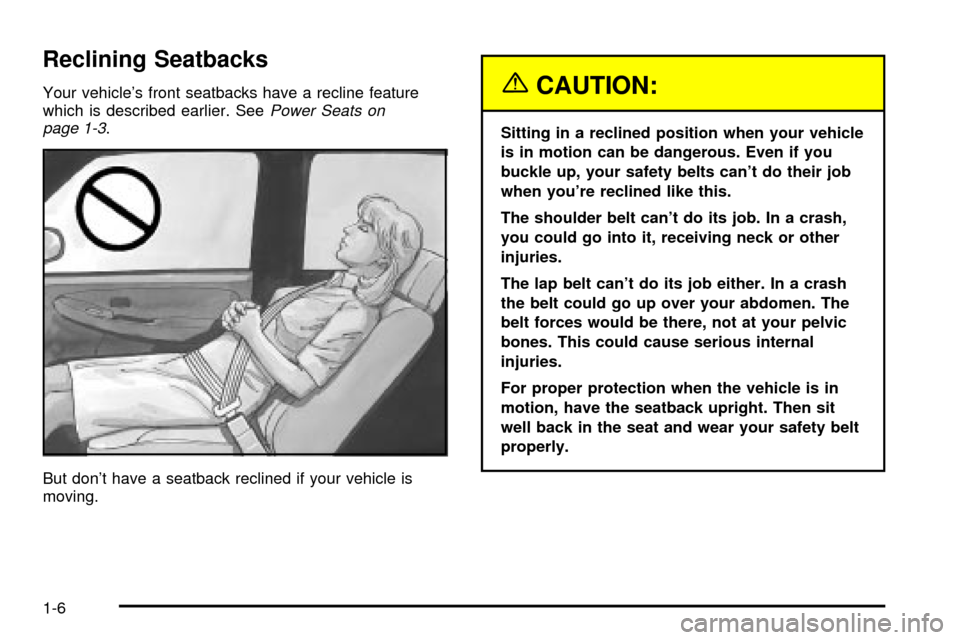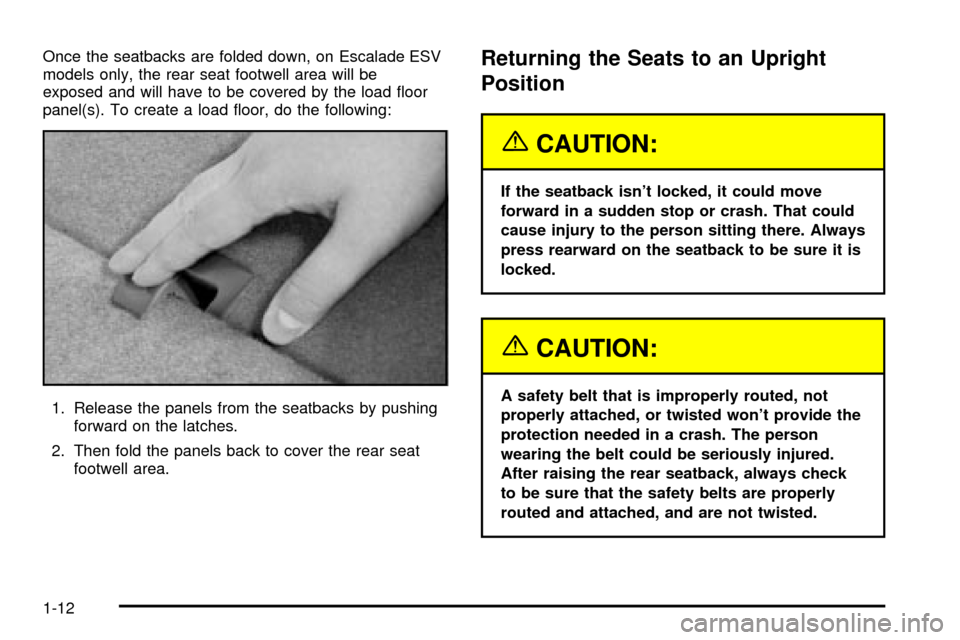seats CADILLAC ESCALADE 2003 2.G Owners Manual
[x] Cancel search | Manufacturer: CADILLAC, Model Year: 2003, Model line: ESCALADE, Model: CADILLAC ESCALADE 2003 2.GPages: 486, PDF Size: 3.32 MB
Page 1 of 486

Seats and Restraint Systems........................... 1-1
Front Seats
............................................... 1-3
Rear Seats
............................................... 1-8
Safety Belts
.............................................1-28
Child Restraints
.......................................1-51
Supplemental Restraint System (SRS)
.........1-76
Restraint System Check
............................1-90
Features and Controls..................................... 2-1
Keys
........................................................ 2-3
Doors and Locks
....................................... 2-8
Windows
.................................................2-16
Theft-Deterrent Systems
............................2-18
Starting and Operating Your Vehicle
...........2-20
Mirrors
....................................................2-33
OnStar
žSystem
......................................2-38
HomeLinkžTransmitter
.............................2-40
Storage Areas
.........................................2-44
Sunroof
..................................................2-49
Vehicle Personalization
.............................2-50
Instrument Panel............................................. 3-1
Instrument Panel Overview
.......................... 3-4
Climate Controls
......................................3-24
Warning Lights, Gages and Indicators
.........3-34
Driver Information Center (DIC)
..................3-51
Audio System(s)
.......................................3-70Driving Your Vehicle....................................... 4-1
Your Driving, the Road, and Your Vehicle
..... 4-2
Towing
...................................................4-50
Service and Appearance Care.......................... 5-1
Service
..................................................... 5-3
Fuel
......................................................... 5-4
Checking Things Under the Hood
...............5-10
All-Wheel Drive
........................................5-50
Rear Axle
...............................................5-51
Front Axle
...............................................5-52
Headlamp Aiming
.....................................5-53
Bulb Replacement
....................................5-57
Windshield Wiper Blade Replacement
.........5-65
Tires
......................................................5-66
Appearance Care
.....................................5-94
Vehicle Identi®cation
...............................5-102
Electrical System
....................................5-102
Capacities and Speci®cations
...................5-112
Normal Maintenance Replacement Parts
......5-114
Maintenance Schedule..................................... 6-1
Maintenance Schedule
................................ 6-2
Customer Assistance Information.................... 7-1
Customer Assistance Information
.................. 7-2
Reporting Safety Defects
...........................7-10
Index................................................................ 1
2003 Cadillac Escalade Owner ManualM
Page 4 of 486

Vehicle Damage Warnings
Also, in this book you will ®nd these notices:
Notice:These mean there is something that could
damage your vehicle.
A notice will tell you about something that can damage
your vehicle. Many times, this damage would not be
covered by your warranty, and it could be costly. But the
notice will tell you what to do to help avoid the
damage.
When you read other manuals, you might see
CAUTION and NOTICE warnings in different colors
or in different words.
You'll also see warning labels on your vehicle. They use
the same words, CAUTION or NOTICE.
Vehicle Symbols
Your vehicle has components and labels that use
symbols instead of text. Symbols, used on your vehicle,
are shown along with the text describing the operation
or information relating to a speci®c component, control,
message, gage or indicator.
If you need help ®guring out a speci®c name of a
component, gage or indicator, reference the following
topics:
·Seats and Restraint Systems in Section 1
·Features and Controls in Section 2
·Instrument Panel Overview in Section 3
·Climate Controls in Section 3
·Warning Lights, Gages and Indicators in Section 3
·Audio System(s) in Section 3
·Engine Compartment Overview in Section 5
iv
Page 7 of 486

Front Seats......................................................1-3
Power Seats..................................................1-3
Power Lumbar...............................................1-4
Heated Seats.................................................1-5
Reclining Seatbacks........................................1-6
Head Restraints.............................................1-7
Rear Seats.......................................................1-8
Rear Seat Operation.......................................1-8
Heated Seats...............................................1-10
60/40 Split Bench Seat..................................1-10
50/50 Split Bench Seat..................................1-13
Bench Seat..................................................1-19
Bucket Seats...............................................1-25
Safety Belts...................................................1-28
Safety Belts: They Are for Everyone................1-28
Questions and Answers About Safety Belts......1-32
How to Wear Safety Belts Properly.................1-33
Driver Position..............................................1-34
Safety Belt Use During Pregnancy..................1-41
Right Front Passenger Position.......................1-42
Center Passenger Position.............................1-42Rear Seat Passengers..................................1-44
Rear Safety Belt Comfort Guides for Children
and Small Adults.......................................1-47
Safety Belt Extender.....................................1-50
Child Restraints.............................................1-51
Older Children..............................................1-51
Infants and Young Children............................1-53
Child Restraint Systems.................................1-57
Where to Put the Restraint.............................1-60
Top Strap....................................................1-61
Top Strap Anchor Location.............................1-63
Lower Anchorages and Top Tethers for
Children (LATCH System)...........................1-65
Securing a Child Restraint Designed for the
LATCH System.........................................1-67
Securing a Child Restraint in a Rear Outside
Seat Position............................................1-67
Securing a Child Restraint in a Center Rear
Seat Position............................................1-70
Securing a Child Restraint in the Right Front
Seat Position............................................1-72
Section 1 Seats and Restraint Systems
1-1
Page 8 of 486

Supplemental Restraint System (SRS)..............1-76
Where Are the Air Bags?...............................1-78
When Should an Air Bag In¯ate?....................1-81
What Makes an Air Bag In¯ate?.....................1-82
How Does an Air Bag Restrain?.....................1-82
What Will You See After an Air Bag In¯ates?.......1-83
Passenger Sensing System............................1-85Servicing Your Air Bag-Equipped Vehicle.........1-89
Adding Equipment to Your Air Bag-Equipped
Vehicle....................................................1-90
Restraint System Check..................................1-90
Checking Your Restraint Systems...................1-90
Replacing Restraint System Parts After a
Crash......................................................1-91
Section 1 Seats and Restraint Systems
1-2
Page 9 of 486

Front Seats
Power Seats
Horizontal Control:You can adjust your vehicle's front
seats with the horizontal control located on the
outboard edge of each front seat.Raise or lower the front of the seat by raising or
lowering the forward edge of the control. Raise or lower
the rear of the seat by raising or lowering the rear
edge of the control.
Move the seat forward or rearward by moving the whole
control toward the front or toward the rear of the
vehicle.
Moving the whole control up or down raises or lowers
the entire seat cushion.
Vertical Control:You can use the vertical control to
adjust the angle of the seatback. Move the reclining
seatback forward or rearward by moving the top of the
control toward the front or toward the rear of the
vehicle.
For information on the reclining seatbacks, see
Reclining
Seatbacks on page 1-6.
Your vehicle may have a memory function which allows
seat settings to be saved and recalled. See
Memory
Seat on page 2-50for more information.
1-3
Page 11 of 486

Heated Seats
The buttons used to
control this feature are
located on the front doors.
The engine must be
running for the heated seat
feature to work.To heat the entire seat, press the horizontal button with
the heated seat symbol. Press the button to cycle
through the temperature settings of high, medium and
low and to turn the heated seat off. Indicator lights
will glow to designate the level of heat selected, three
for high, two for medium, and one for low.
The low setting warms the seatback and cushion until
the seat temperature is near body temperature. The
medium and high settings heat the seatback and seat
cushion to a slightly higher temperature. You will be able
to feel heat in about two minutes.
To heat only the seatback, press the vertical button with
the heated seatback symbol. An indicator light on the
seatback button will glow to designate that only the
seatback is being heated. Additional presses of
the seatback button will cycle through the heat levels for
the seatback only. Press the horizontal button again
to heat the whole seat.
The heated front seats will shut off automatically when
the ignition is turned off.
Your vehicle also has heated rear seats. See
Heated
Seats on page 1-10.
1-5
Page 12 of 486

Reclining Seatbacks
Your vehicle's front seatbacks have a recline feature
which is described earlier. SeePower Seats on
page 1-3.
But don't have a seatback reclined if your vehicle is
moving.
{CAUTION:
Sitting in a reclined position when your vehicle
is in motion can be dangerous. Even if you
buckle up, your safety belts can't do their job
when you're reclined like this.
The shoulder belt can't do its job. In a crash,
you could go into it, receiving neck or other
injuries.
The lap belt can't do its job either. In a crash
the belt could go up over your abdomen. The
belt forces would be there, not at your pelvic
bones. This could cause serious internal
injuries.
For proper protection when the vehicle is in
motion, have the seatback upright. Then sit
well back in the seat and wear your safety belt
properly.
1-6
Page 14 of 486

Rear Seats
Rear Seat Operation
Entering or Exiting the Third Row
Seats
Escalade:To enter or exit the third row seat you must
fold the second row seat down following the instructions
later in this section. See ªFolding the Seatbackº
under
60/40 Split Bench Seat on page 1-10.If you are exiting the third row seat with no assistance
do the following:
1. Reach over the second
row seat and pull up on
the strap loop. Then
pull the seat cushion up
and push it forward.
2. Next, push the seatback forward until it is ¯at with
the ¯oor.
Be sure to return the seat to the passenger position
when ®nished. Pull forward and push rearward on the
seat to make sure it is locked in place.
Escalade ESV:The passenger's side of the second
row 60/40 or rear bucket seat has an easy entry/exit
feature. This makes it easy to get in and out of the third
row seat.
1-8
Page 16 of 486

Heated Seats
If your vehicle has this
feature, the buttons used
to control this feature
are located on the back of
the center console. The
engine must be running for
the heated seat feature
to work.
To heat the seat, press the button to cycle through the
temperature settings of high and low. Press the
button a third time to turn the feature off. An indicator
light will glow for each heat setting when the feature is
operating.
The heated rear seats will shut off automatically when
the ignition is turned off.
60/40 Split Bench Seat
If your vehicle has a 60/40 split bench, the seatbacks
can be folded to give you more cargo space.
Folding the Seatbacks (60/40 Split
Bench Seat)
The rear seat may have a 60/40 split seat which may be
folded down to create a load ¯oor and give you more
cargo space. On the Escalade, the rear seatbacks
are equipped with rearward folding head restraints.
When the seatback is being folded down, the head
restraint will automatically fold rearward.
1-10
Page 18 of 486

Once the seatbacks are folded down, on Escalade ESV
models only, the rear seat footwell area will be
exposed and will have to be covered by the load ¯oor
panel(s). To create a load ¯oor, do the following:
1. Release the panels from the seatbacks by pushing
forward on the latches.
2. Then fold the panels back to cover the rear seat
footwell area.Returning the Seats to an Upright
Position
{CAUTION:
If the seatback isn't locked, it could move
forward in a sudden stop or crash. That could
cause injury to the person sitting there. Always
press rearward on the seatback to be sure it is
locked.
{CAUTION:
A safety belt that is improperly routed, not
properly attached, or twisted won't provide the
protection needed in a crash. The person
wearing the belt could be seriously injured.
After raising the rear seatback, always check
to be sure that the safety belts are properly
routed and attached, and are not twisted.
1-12